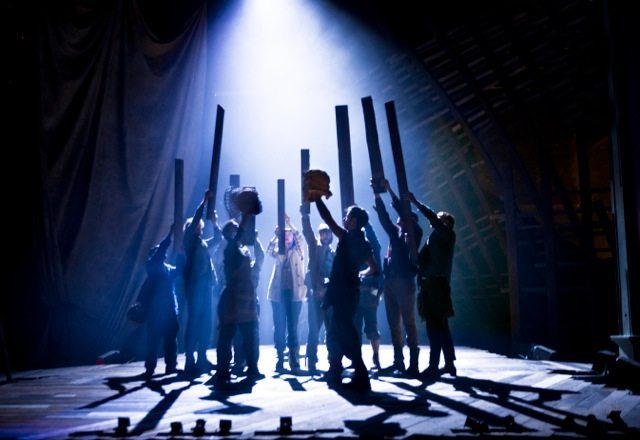A Midsummer Night’s Dream comes to the Barbican
Arts Editor, Rebekah Ellerby, reflects on Handspring Puppet Company’s A Midsummer Night’s Dream and its upcoming transfer to the Barbican in February. It is produced in partnership with Bristol Old Vic where she originally saw the production last year.
At the beginning of 2013, War Horse celebrated its 2000th West End production and Handspring Puppet Company have ridden forward from the beautiful puppetry of the National Theatre’s starry production to new successes in another realm of puppetry, here dealing with Shakespeare.
There is a lot to be said of theatres jumping on the bandwagon of commercial success. Lyn Gardner has recently critiqued the frequency of star actors being used, however fantastic they might be in their roles, to sell Shakespearean shows that otherwise are average, mediocre or uninspiring. Puppets are in vogue. I don’t know anyone with cultural kudos who hasn’t seen or doesn’t want to see War Horse. So perhaps I shouldn’t be, given this puppet phase, but I am hugely surprised that this production of A Midsummer Night’s Dream has been deemed successful enough to transfer to the Barbican.
In my original review of the production, I called it ‘a raucously funny and rude ride’ but ‘a little too full of puppets’. The production goes for puppet overload, in all different forms, possibly even challenging how we conceive the idea of a ‘puppet’. But some of these ideas were fundamentally ineffective, nay, even distracting. Tom Morris, the director, in the programme notes said he decided to bring attention on stage to both the puppet and the puppeteer, in an attempt to eliminate the idea that the actor can embody both simultaneously.
Predominantly, this was effected using small puppets crafted to look like miniature versions of the actors. The actors would interact with their puppets as though separate beings, achieving the alienation between puppet and puppeteer Morris aspired to. These puppets might be left in still images, while the actors carried on the scene as their characters, leaving their puppet counterparts frozen and watching. Or they would treat their puppet double like a doll, a strange part of themselves to direct their speech at. The problem was, that this left no sympathy for the puppets themselves. In fact, it was unclear what function these puppets fulfilled at all.
What we lacked in Morris’s distancing effect between puppet and puppeteer was the focus on the storytelling. While this particular use of the puppet achieved a progressive theatrical conceit, it was to the detriment of the story and became an unnecessary and confusing distraction.
I didn’t mind at all the innovations in interpretation the production made. The controlling force of the fairies, only hinted at in the text, comes out of ambiguity at the end of this production, with the Fairy King and Queen seen puppeteering the human characters into sleeping poses. In the text, Bottom just has Donkey’s ears, but here Bottom is embroiled in a full mechanical contraption to daringly rude effect. While in the early modern period ‘bottom’ was not used to describe that part of the body, this production punned hilarious on the word. There is of course no pure and transcendent ‘Shakespeare’, only cultural reproduction, and the anachronism of an early modern play being produced on a modern stage.
But what this production failed to do, was achieve as theatre. Shakespeare aside, puppetry works so marvellously in War Horse because it makes itself appear necessary. Whether that be for the practical reasons that horses and other animals could not populate the stage, or for aesthetic reasons that the story could not be told without the puppets and style of theatre achieved with them.
The puppets that worked in A Midsummer Night’s Dream were those where the innovation made you think ‘yes, that concept could only be achieved with that puppet’. Puck, for instance, was created by various puppeteers holding found objects to make a skittish, dog-like creature. This allowed theatrical magic – the objects could disappear with lightning speed. Here, puppetry was a solution to the illusion of magic needed for the story.
I have said where I found this production ineffective in its conception but perhaps am overlooking the hilarity and bare faced ‘cheek’ I enjoyed when first encountering it. Nonetheless, the critics seemed united in finding the production mediocre. Lyn Gardner gave it 3 stars and called it ‘by no means a triumph’, Paul Taylor judged it similarly, saying, ‘in practice, the idea works only fitfully – some aspects almost soar; others sag’ and Charles Spencer was even harsher with 2 stars, deeming it ‘misguided and indulgent’. Why then, have the Barbican decided to host its transfer?
Tweet @BoarArts with your opinions.
A Midsummer Night’s Dream is at the Barbican 6-15 February 2014. For further details about this production click here. The Barbican sells half-price advance tickets for students on Wednesday evenings.

Comments (2)
The production has changed a lot since you wrote this review however. The lovers now don’t use puppets at all…rather than regurgitating a review why don’t you go and watch the refreshed version?